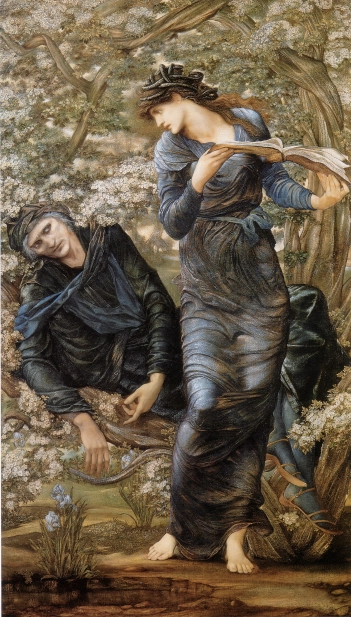
Edward Burne-Jones was obsessed with the legends of King Arthur. As a young man he had stumbled upon an old edition of the tales in a shop and had visited the shop each day until he’d read every word.
The Arthurian legends proved to be an inspiration for Burne-Jones’ artistic works throughout his career. The themes of heroism, love and honour feature regularly in his work and proved extremely popular with the late Victorian public. This painting depicts Merlin who had fallen in love with Nimue, a lady of the lake. Nimue was ambitious and used Merlin’s infatuation with her to learn the secret of his magic. She is shown reading from Merlin’s book of spells to send him into a deep sleep. Trapped inside a hawthorn bush and rapidly succumbing to the spell, he looks up at her, his eyes pleading with her to release him. Nimue towers over the now powerless wizard; her expression denotes surprise at the power she now wields.
The inspiration for Nimue was Maria Zambaco, an educated and well-travelled member of a wealthy Greek family. She was also an accomplished artist and this brought her into contact with the pre-Rapahelite painters. Her classical looks and moody, expressive eyes made her a popular model. Like Merlin, Burne-Jones became infatuated with Zambaco. In 1869, he attempted to leave his wife for her which, even in the broad-minded artistic community, caused a great scandal. Maria begged him to commit suicide with her, planning to overdose on laudanum next to the canal in Little Venice, but the police were called and the situation diffused. Eventually their affair came to an end, but Burne-Jones continued to use Maria in his works, frequently portraying her as a sorceress or a temptress. It was revealed in his letters after his death that Burne-Jones felt that his love and infatuation for Maria paralleled Merlin’s infatuation with Nimue.
This painting can be seen in the newly refurbished Lady Lever Art Gallery in Port Sunlight, which is open daily from 10am to 5pm and admission is free.
Why you should see this painting:
A classical tale of romance and infatuation is expressed entirely through the eyes of the two characters. Yet the rest of the work perfectly demonstrates Burne-Jones’ mastery of fine detail and aestheticism.
First published in Cheshire Life February 2017